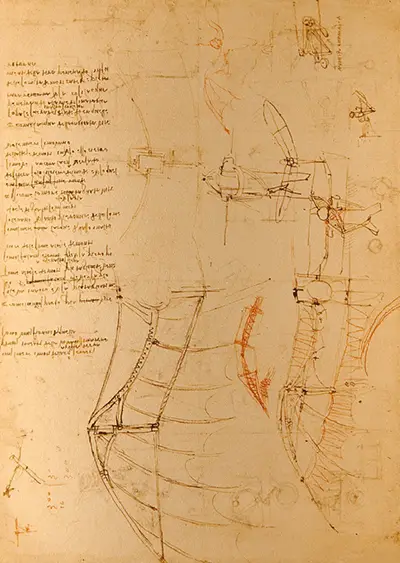Leonardo da Vinci was fascinated by the phenomenon of flight, and produced many studies of birds and designs for flying machines.
Most of da Vinci's creations proved ineffective. However, some were more practical, and the light hang glider he envisioned has been successfully constructed and demonstrated.
The design in this diagram is reminiscent of a bird's wing, drawing a parallel to Leonardo da Vinci's elaborate studies of the flight of birds, including his Codex on the Flight of Birds, circa 1505. Leonard da Vinci's fascination and close observation of the natural world provided a foundation for his ventures in to avian design.
His fascination in flight appears to have been developed by his extensive work on military technology at the Milanese court. Leonardo da Vinci examined and analysed the relationship between the shape and movement of creatures born with the ability to fly, and aerodynamics.
He made elaborate observations regarding the balance, control and weight displacement of bats and birds. Leonardo da Vinci also recognised the importance of lightweight material in aeronautical creation. He also hinted at a force later defined by Newton as gravity.
In these diagrams, all sketches have a primary focus on the framework of a wing, which replicate the complex bone structure of the wing of a bird or bat. Leonardo da Vinci evidently took inspiration from a bat's anatomical structure in the creation of these designs.
The centre of the invention suggests a harness to contain a human and is reminiscent of the notarium and scapular of a bat or the clavicle of a bird. The top line of support along this design strongly replicates the upper arm and forearm of a bird and bat, while the faint lines extending from these resemble a bat's fingers. A bat's winged membrane inspires the design of the body of the wings.
This design is a classic example of Leonardo da Vinci's exploration of avian invention. In his own notes, the polymath revealed bats, birds and kites as sources of inspiration, and most of his designs were ornithopters - machines designed to achieve flight by means of flapping wings.
Many of Leonardo da Vinci's inventions feature an enormous pair of wings, some with the wingspan exceeding 33 feet, attached to a framework made of pine wood. Raw silk appears to have been da Vinci's choice for the wing fabric, as it was a light but sturdy membrane.
The pilot would lie face down, harnessed to the wooden framework of the design, and would navigate the 'flying machine' by a crank which moved the wings via a series of pulleys and rods.
Leonardo da Vinci never actually built the invention in this diagram. Without an engine or source of power, it is unclear how the device could have become airborne.
This impracticality was an issue shared by many of his aeronautical designs, such as his aerial screw helicopter design, which was unable to provide lift.
Regardless of the success of his inventions, Leonardo da Vinci never lost his fascination and enthusiasm for flight. Over his lifetime he produced over 35,000 words and 500 sketches covering flying machines, aerodynamics and the flight of bats and birds.



